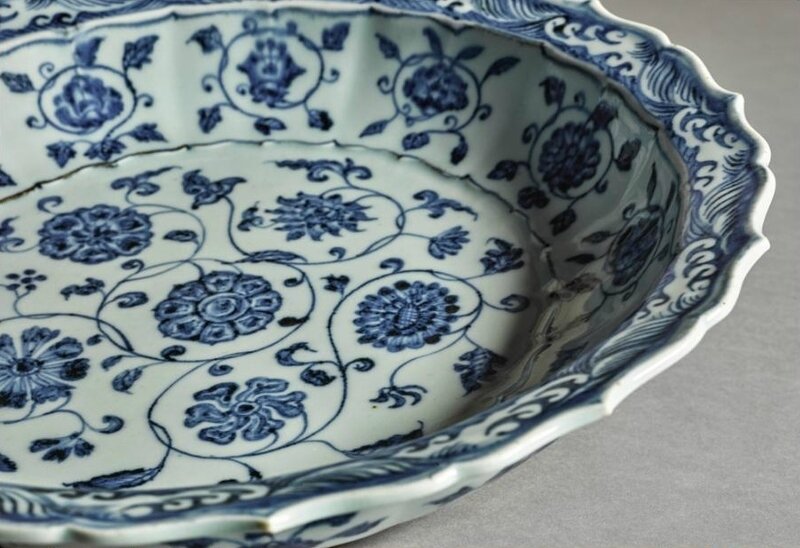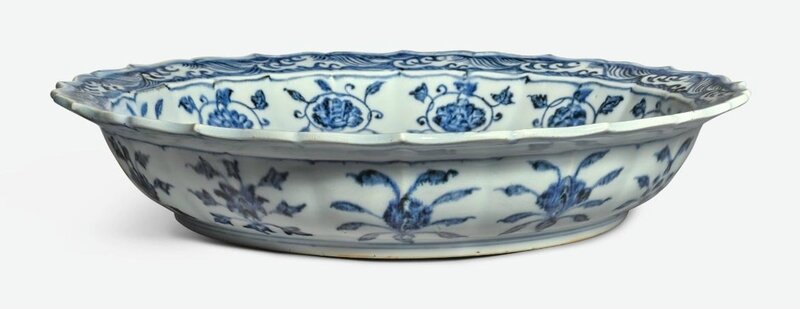A fine blue and white barbed rim 'floral scroll' dish, Ming dynasty, Yongle period (1403-1424)
Lot 1. A fine blue and white barbed rim 'floral scroll' dish, Ming dynasty, Yongle period (1403-1424). Estimation 200,000 — 300,000 USD. Lot sold 732,500 USD. Photo: Sotheby's.
very finely potted with shallow rounded sides divided into twelve bracket foliations, rising from a short tapered foot to a barbed everted rim, deftly and richly painted in shades of cobalt blue with a central lotus bloom to the interior, shown en face surrounded by blooms of camellia, lotus, chrysanthemum, mallow and pink, all wreathed by interlocked meandering stems within a barbed line border, further encircled around the sides by detached sprays of peony, chrysanthemum, pomegranate, hibiscus, morning glory and lotus, each repeated twice and paired across the dish, all framed by a border of cresting waves emitting white foam within double-lines at the rim, the exterior painted with similar detached floral sprays within double-line borders, the base and footring left unglazed - Diameter 13 1/8 in., 33.5 cm
Provenance: Sotheby's London, 15th December 1987, lot 144.
Note: Large dishes such as the present example were an innovation of the Yuan dynasty and their continued production during the Yongle reign may reflect the Yongle Emperor’s interest in having imperial kilns create porcelains suitable for export. Even today, more dishes of this type are preserved in the royal collections of the Safavids in Iran and the Ottomans in Turkey than in China or elsewhere. Their availability appears, however, to have been strictly controlled by the court and their sale may have been effected directly through the fleets of Zheng He (1371-1435), the imperial eunuch who led six immense maritime expeditions westwards as far as East Africa for the Yongle Emperor. Excavations of the Ming imperial kiln site at Zhushan in Jingdezhen have shown that Yongle dishes of this type can be attributed to the early part of the reign as shards of such large blue and white vessels have been discovered, for example, in stratum three of the Zhonghua Road excavation site in Jingdezhen immediately above the Hongwu stratum.
One of the most striking decorative innovations of early fifteenth century wares was the use of separate floral sprays or bunches of flowers in the cavetto instead of the continuous scroll. The heavy wreath of lotus or peony found on fourteenth century dishes gave way to a series of delicate and more varied motifs. Twelve flower sprays consisting of two sets were commonly repeated so that each flower was diametrically opposite its pair. With each flower spray encircled by a stem with leaves, the present dish is characteristic of the delicate variety that occurred within Yongle design schemes.
A similar dish in the Topkapi Saray Museum, Istanbul, is illustrated in Regina Krahl, Chinese Ceramics in the Topkapi Saray Museum, Istanbul, London, 1986, vol. II, pl. 601; another from the collection of Sir Percival David, now in the British Museum, London, is published in Oriental Ceramics. The World’s Great Collections, Tokyo, 1982, vol. 6, pl. 76; one in the National Palace Museum, Taipei, was included in the Museum’s Special Exhibition of Early Ming Porcelains, National Palace Museum, Taipei, 1982, cat. no. 38; and a fourth is published in Mayuyama, Seventy Years, Tokyo, 1976, vol. 1, pl. 753. Other dishes of this design include two in the Museum of Far Eastern Antiquities, Stockholm, illustrated in Jan Wirgin, Chinese Ceramics from the Axel and Nora Lundgren Bequest, Stockholm, 1978, pl. 27, no. 25; one from the Mottahedeh collection, illustrated in Michael Howard and John Ayers, China for the West. Chinese Porcelain and Other Decorative Arts for Export, New York, 1978, vol. 1, p. 12, and sold in these rooms, 20th March 1976, lot 113, and again 20th September 2000, lot 105; and a third sold in our Hong Kong rooms, 8th April 2013, lot 3018.

/https%3A%2F%2Fprofilepics.canalblog.com%2Fprofilepics%2F1%2F0%2F100183.jpg)
/https%3A%2F%2Fstorage.canalblog.com%2F03%2F02%2F119589%2F96711876_o.jpg)
/https%3A%2F%2Fstorage.canalblog.com%2F11%2F31%2F119589%2F94773502_o.jpg)
/https%3A%2F%2Fstorage.canalblog.com%2F20%2F83%2F119589%2F94772815_o.jpg)
/https%3A%2F%2Fstorage.canalblog.com%2F26%2F72%2F119589%2F75604929_o.jpg)
/https%3A%2F%2Fstorage.canalblog.com%2F59%2F60%2F119589%2F26458628_o.jpg)






/image%2F1371349%2F20240416%2Fob_2a8420_437713933-1652609748842371-16764302136.jpg)
/image%2F1371349%2F20240414%2Fob_83ee65_2024-nyr-22642-0954-000-a-blue-and-whi.jpg)
/image%2F1371349%2F20240414%2Fob_15808c_2024-nyr-22642-0953-000-a-blue-and-whi.jpg)
/image%2F1371349%2F20240414%2Fob_e54295_2024-nyr-22642-0952-000-a-rare-blue-an.jpg)